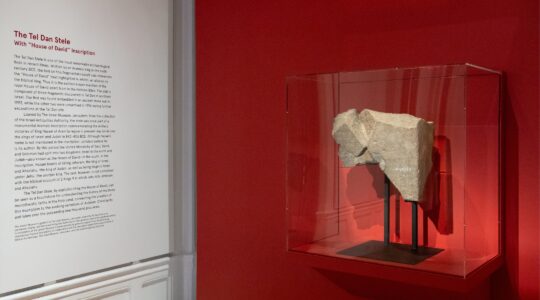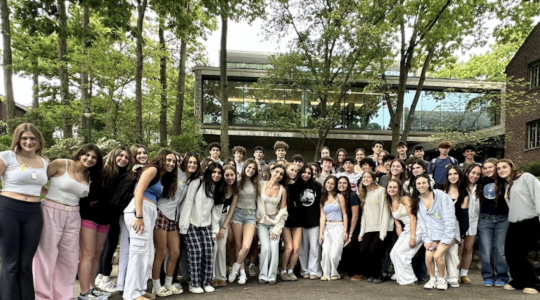If you are driving through Western Europe, at some point you may find yourself in Luxembourg. You will feel a little thrill at being able to check off another country, and with barely any effort: At just under 1,000 square miles, this trilingual nation — wedged between Germany, France and Belgium — is smaller than Rhode Island.
Geography has certainly been destiny for Luxembourg, and for its substantial Jewish community as well. Jews from France and other neighboring countries, drawn to Luxembourg’s banking sector and open, cultivated society, have lately boosted the Jewish population to 1,200, making Luxembourg one of the few countries in Europe to have more Jews today than before World War II.
But that same proximity has put Luxembourg in the literal crossfire; the Battle of the Bulge was fought here, as the Germans mounted their last major offensive. Years earlier, on the eve of the war, at least 2,000 Jewish refugees had poured into Luxembourg from Nazi-occupied Germany. Many Jews, in turn, fled Luxembourg as the Nazis descended; many more perished in the Holocaust.
You can explore that terrible era in depth at the National Museum of Military History, a short drive north from the capital through Luxembourg’s thick, dark forests. World War II history buffs will enjoy the museum’s vintage tanks and trucks, and everyone is impressed by life-sized recreations of battle scenes (including mud-smeared soldier mannequins).
Luxembourg’s most famous native son may be the photographer Edward Steichen, whose magnum opus — a photography collection, “The Family of Man,” created for the Museum of Modern Art — is on view in the northern town of Clervaux. Steichen made his career in America, promoted by the Jewish photographer and art world figure Alfred Stieglitz, a longtime collaborator.
It is hard to overstate the aesthetic impact of “The Family of Man,” which displays hundreds of images of ordinary people in 68 different countries. With text by Steichen’s brother-in-law, the poet Carl Sandburg, the show traveled to dozens of cities around the globe in the years following its 1955 MoMA debut.
Today, Steichen’s expansive, humanist vision is a UNESCO World Heritage Site. The exhibition shares space in Clervaux Castle with the Museum of the Battle of the Bulge, marking an event that took place on these very grounds: Clervaux’s 13th-century castle burned down during the battle, and was subsequently rebuilt.
Luxembourg’s thousand-year history is visible throughout the country. Nowhere is it more evident, however, than in the capital, Luxembourg City, whose compact size and fairytale landscape make it a delight for visitors.
The capital’s medieval fortifications sprawl dramatically over vertiginous cliffs; a promenade along the Chemin de la Corniche overlooks river gorges, ancient tunnels and the sloping roofs of Old Town. Today, Luxembourg’s modern glass towers are symbols of Continental cooperation, hosting key agencies of the European Union, including the European Investment Bank (and many other banks as well).
But the city’s medieval ramparts reflect a significantly more conflict-ridden past. Nearly every surrounding country has controlled Luxembourg at some point, and contributed to the mix of influences in its architecture (including several renowned museums and the ducal palace) — as is evident in the country’s French-accented bistros.
About those bistros: Luxembourg boasts that its restaurants have more Michelin stars per square mile than anyplace else, making the capital as much a dining as a banking destination. Indeed, Luxembourg City is a lot more cosmopolitan than the size of its population — just over 100,000 — would suggest, with a vibrant economy that attracts a steady influx of European, often Jewish professionals.
Like a lot of the buildings, Luxembourg’s Jewish community traces its roots to the 13th century. But successive expulsions vanquished Luxembourgian Jewry until its resurgence in the 1800s, when a Jewish middle class built institutions in the capital and a half-dozen other towns.
Support the New York Jewish Week
Our nonprofit newsroom depends on readers like you. Make a donation now to support independent Jewish journalism in New York.
Today, synagogues are active in Luxembourg City and in the southern metropolis of Esch-sur-Alzette. Luxembourg City is the hub of modern Jewish life; in addition to the elegant, park-side synagogue and community offices, the city hosts a Chabad center and two historic Jewish cemeteries.
But another outpost of Luxembourg Jewry is alive some 6,000 miles to the west, on 110th Street in Manhattan. As Upper West Siders may know, that’s where the Orthodox Congregation Ramath Orah was founded in 1941 by 61 Luxembourgian Jewish refugees. “Ramath Orah” means “Mountain of Light,” a direct translation of the name Luxembourg — and a tribute to a tiny but memorable medieval city built over vertiginous cliffs in the heart of Europe.
The New York Jewish Week brings you the stories behind the headlines, keeping you connected to Jewish life in New York. Help sustain the reporting you trust by donating today.




